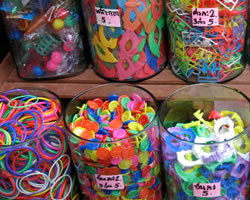Children are just as likely to choose a small toy as candy when offered both on Halloween, according to a Yale study.
Given the choice between lollipops, fruit-flavored chewy candies, fruit flavored crunchy wafers, and sweet and tart hard candies, or stretch pumpkin men, large glow-in-the-dark insects, Halloween theme stickers and pencils, half the children chose the toys.
“This finding may reassure adults that children will not be disappointed by non-candy treats,” said Marlene Schwartz, associate research scientist in the Department of Psychology and principal investigator of the study published in a recent issue of the Journal of Nutrition, Education and Behavior.
“The purpose of this study was to show that children will respond favorably to efforts to provide an alternative to candy.”
The study conducted on Halloween last year included 284 children between three and 14-years old who trick-or-treated at seven homes in five different Connecticut towns.
Adults accompanied some of the children and others were alone. The toys and candy were comparable in size, color and cost. There were two plates with four types of toys on one and four types of candy on another. Half the children chose toys and half chose candy.
Schwartz said some people might argue that Halloween comes only once a year, so it is not necessary to worry about unhealthy food choices for one night.

Small toys are great for Halloween instead of candy.
However, she said children are offered candy frequently — on holidays, birthday parties, and other social events.
“As a society we have gotten into the mindset that the only way to celebrate special occasions with children is with something sweet,” she said. “And, we are sending a mixed message by telling children they need to eat one way and then feeding them in another.”
Kelly Brownell, director of the Yale Center for Eating and Weight Disorders and senior author of the study, said anything that can steer children away from unhealthy food is a positive development. “Poor diet is taking its toll on the health and happiness of America’s children,” he said.
Citation: Journal of Nutrition, Education and Behavior, Vol. 35: pp 207-209 (July/August).











